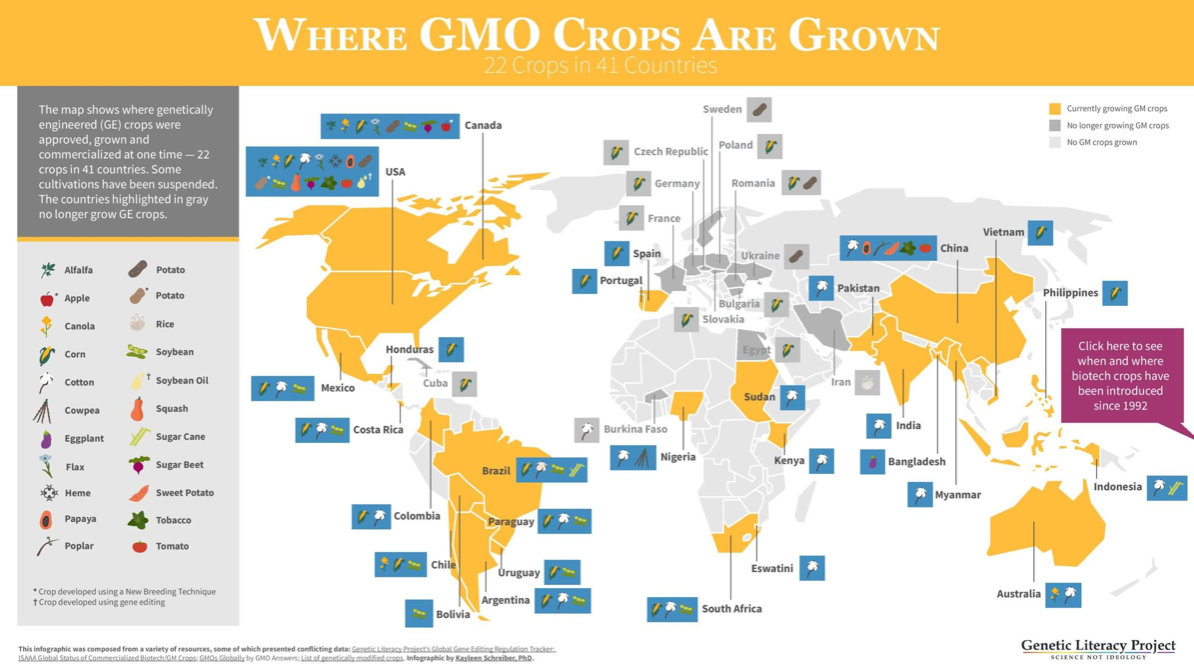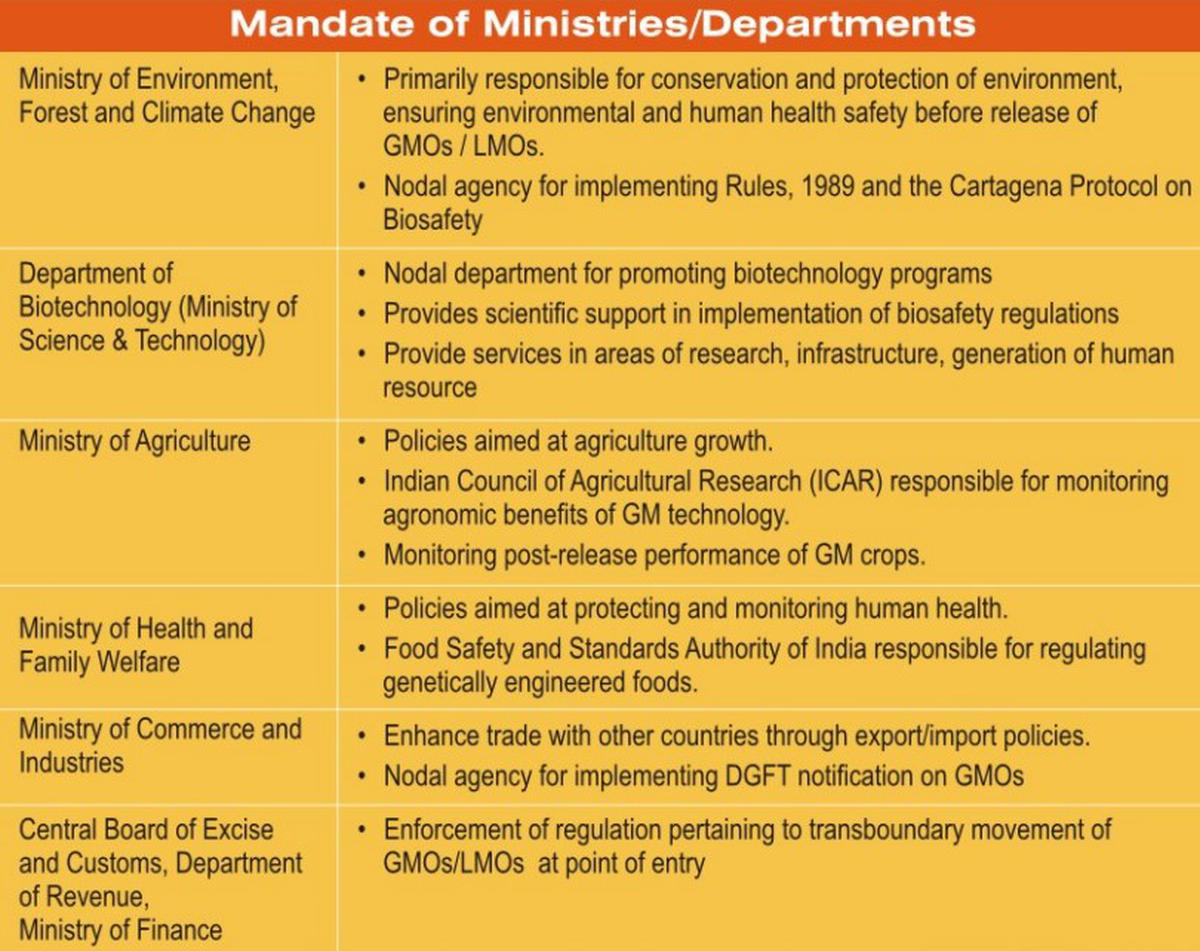ForumIAS announcing GS Foundation Program for UPSC CSE 2025-26 from 19 April. Click Here for more information.
Contents
| For 7PM Editorial Archives click HERE → |
Introduction
Transgenic crops are subject of significant debate in India. Despite their potential to combat agricultural challenges, they raise concerns regarding their impact on the environment and human health.
Recently, three Indian states – Gujarat, Maharashtra, and Telangana – have delayed testing a new transgenic cotton seed, approved by the Centre’s Genetic Engineering Appraisal Committee (GEAC). This situation highlights the ongoing challenges and complexities surrounding the acceptance and implementation of transgenic crops in India.
What are transgenic crops?
Transgenic crops, also known as genetically modified organisms (GMOs), are plants that have had their DNA altered using genetic engineering techniques. This process involves inserting one or more genes from a different species into the plant’s genome to confer certain advantageous traits that aren’t naturally present in the species.
An example of a transgenic crop is Bt cotton, which is widely grown in several countries, including India.
Transgenic crops like these are developed to improve crop yield, enhance nutritional value, reduce the use of chemical pesticides, and increase resistance to environmental stressors like drought or frost. However, the use of GMOs also raises concerns related to potential health risks, environmental impact, and ethical considerations.
About the transgenic crops permitted in India and in other countries

Transgenic crops in India
Bt cotton: In India, the major transgenic crop that has been commercialized is Bt cotton. Bt cotton is genetically modified cotton that expresses a toxin derived from the bacterium Bacillus thuringiensis, which provides resistance against destructive pests such as the bollworm.
GM mustard: In addition, India is also considering the commercial release of genetically modified mustard known as Dhara Mustard Hybrid (DMH -11). This GM mustard has genes from a soil bacterium that enhance hybridization, potentially leading to a yield increase of 25-30%. As of now, this crop has received approval from the GEAC but is yet to receive final clearance from the Ministry of Environment.
Other transgenic crops which are under developmental phases in India
GE banana: The National Agri-Food Biotechnology Institute (NABI) in Mohali is developing fungus-resistant varieties and exploring the fortification of bananas with iron. They are also working on increasing the amount of provitamin A in the fruit.
GE potato: The Central Potato Research Institute (CPRI) in Shimla has received permission to conduct research on the GE potato hybrid KJ66, derived from the wild Mexican potato, aimed at combating the late blight pathogen Phytophthora infestans.
GE maize: Rallis India Limited has received conditional approval from GEAC to conduct trials on GE maize, aimed at improving its resistance to the moth Spodoptera frugiperda and tolerance to the herbicide glyphosate.
GE rubber: The Rubber Research Institute in Kottayam has been granted permission for trials of two GE rubber lines expressing an ‘osmotin’ gene, which is expected to confer resilience to the plants under a range of adverse conditions.
Transgenic crops in other countries
Soybeans: In the United States, one of the first and most widespread transgenic crops is the Roundup Ready soybean. These soybeans are engineered to be resistant to glyphosate, the active ingredient in the herbicide Roundup.
Bt maize: Another common transgenic crop is Bt maize (or corn), which like Bt cotton, contains a gene from the Bacillus thuringiensis bacterium. This allows the maize to produce a protein that is toxic to certain types of pests, notably the European corn borer.
Golden rice: In some parts of Asia, a genetically modified version of rice known as Golden Rice has been developed. This rice is modified to produce beta-carotene, a precursor of vitamin A, in the edible parts of the rice plant. This is intended to combat vitamin A deficiency, a significant public health problem in many developing countries.
| Must read: GM Crops in India: Issues and challenges – Explained, pointwise |
How India is regulating transgenic crops?

India has a well-established regulatory framework in place to control and supervise the introduction and cultivation of GM crops. This is governed by various rules, regulations, and guidelines set by different ministries and departments.
The Genetic Engineering Appraisal Committee (GEAC): The committee reviews proposals related to the release of GM organisms and products into the environment, including experimental field trials.
Environment Protection Act: The GEAC or people authorised by it have the power to take punitive actions under the Environment Protection Act.
Role of the Indian Council of Agriculture Research (ICAR): The ICAR plays a crucial role in supervising the development of new GM varieties and hybrids. For example, the recent approval for GM mustard allows for the environmental release of two genetically engineered mustard varieties under the supervision of the ICAR.
Assessment of Risks: The regulatory framework also requires the evaluation of potential risks to human health, animal health, and biodiversity. This involves rigorous testing under laboratory and field conditions to ensure the safety and efficacy of GM crops.
Public Consultation: In some cases, public consultation is also part of the process before a final decision is made about the commercialization of a GM crop. This allows stakeholders, including the public, to voice their concerns and opinions.
| Read more: Genetic Engineering Appraisal Committee approves commercial cultivation of genetically modified mustard yet again |
What are the arguments supporting the introduction of transgenic crops in India?
Addressing food security: One of the main arguments supporting the introduction of transgenic crops in India is the potential to enhance food security. With India’s population continually growing, transgenic crops offer a promising solution to increase agricultural yield and meet the escalating food demand.
Improved crop characteristics: Transgenic crops can be engineered to have desired traits such as drought resistance, pest resistance, and improved nutritional content. These modifications can lead to healthier, more resilient crops that are better suited to varying climatic conditions and can contribute to higher yields.
Economic benefits for farmers: Transgenic crops can provide economic advantages to farmers. The use of crops genetically engineered to resist pests, for instance, can reduce the need for expensive pesticides. The GEAC’s recent approval of GM mustard is a prime example of this, with the potential to boost yield and subsequently increase farmers’ income.
Potential environmental benefits: By reducing the need for chemical pesticides and herbicides, transgenic crops may also help decrease environmental pollution. Furthermore, certain GM crops may require less water, contributing to more sustainable water use.
Enhanced crop diversity: Transgenic technology can facilitate the development of new crop varieties, enhancing agricultural biodiversity. This could offer farmers a greater choice of crops to cultivate, potentially leading to more diverse farming systems.
What are the arguments against the introduction of transgenic crops in India?
Health concerns: Some groups argue that the consumption of genetically modified crops could potentially lead to health issues. There are concerns about allergenicity, antibiotic resistance, and the overall safety of consuming foods derived from GMOs.
Impact on biodiversity: Critics also argue that the introduction of transgenic crops could negatively impact biodiversity. There are concerns that the proliferation of GM crops could lead to the genetic contamination of wild relatives of the modified crops. The increased use of herbicide-resistant crops could harm non-target organisms and beneficial insects.
Potential socio-economic implications: There are also socioeconomic considerations. For instance, small farmers might face difficulties if they cannot afford the often higher-priced GM seeds, potentially exacerbating economic inequalities in rural communities.
Dependence on multinational companies: Many GM seeds are patented by multinational corporations. Farmers using these seeds would be dependent on these companies for their supply, potentially leading to monopolistic practices and loss of control over their own agricultural practices.
Ethical and cultural concerns: For some, the genetic modification of crops raises ethical questions about human intervention in nature. These can be especially potent in countries like India with rich cultural and religious traditions tied to natural processes.
What should be done?
Enhanced research and development: To address concerns related to transgenic crops, further research and development should be undertaken. This should focus on comprehensive risk assessment, long-term impact studies, and the development of techniques to prevent cross-contamination.
Rigorous regulatory framework: The regulatory framework for the approval and monitoring of transgenic crops in India needs to be rigorous. This can help ensure that only those GM crops that are safe for human health and the environment are permitted.
Capacity building in biotechnology: India needs to enhance its capacity in the field of biotechnology. This involves training scientists in advanced techniques, and creating world-class laboratories that can undertake cutting-edge research in this field.
Public awareness and engagement: Transparent, evidence-based information on GM crops should be shared with the public to address concerns and misconceptions. This could involve engaging with communities through public consultations before the introduction of GM crops.
Protecting farmers’ interests: Policies should be in place to protect farmers from potential exploitation by multinational companies selling GM seeds. This includes ensuring farmers have access to a variety of seeds, including non-GM options.
Monitoring environmental impact: After the introduction, transgenic crops should be continuously monitored to assess their impact on biodiversity and ecosystems. In particular, the potential for gene flow to non-target species should be rigorously evaluated.
International collaboration: India can benefit from international collaboration in this field, learning from the experiences of other countries that have successfully adopted transgenic crops, and working together to address shared challenges.
Sources: Indian Express (Article 1, Article 2 and Article 3), The Hindu (Article 1, Article 2 and Article 3), Counter view, The Print, India Today, Weather, DTE and The Hindu Businessline
Syllabus: GS 3: Science and Technology: Awareness in the field of biotechnology.




